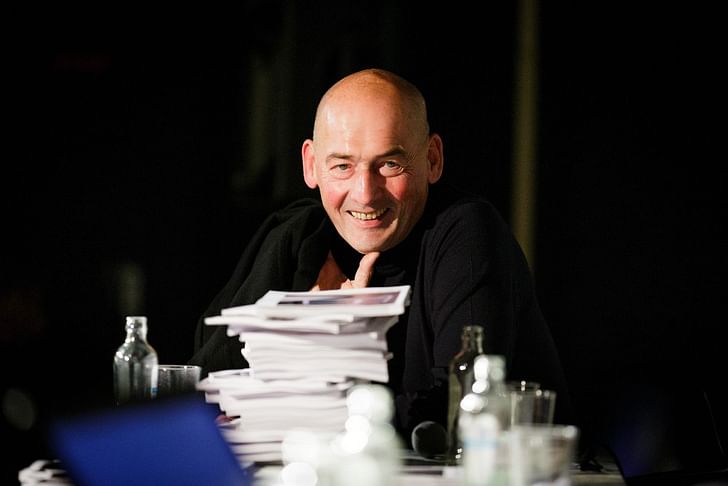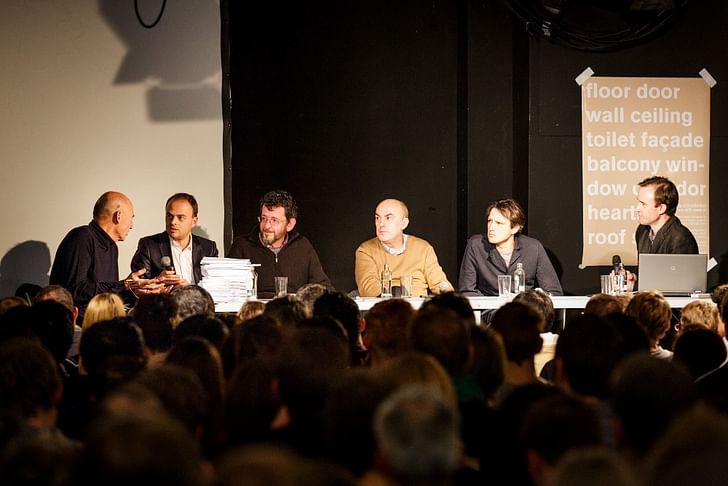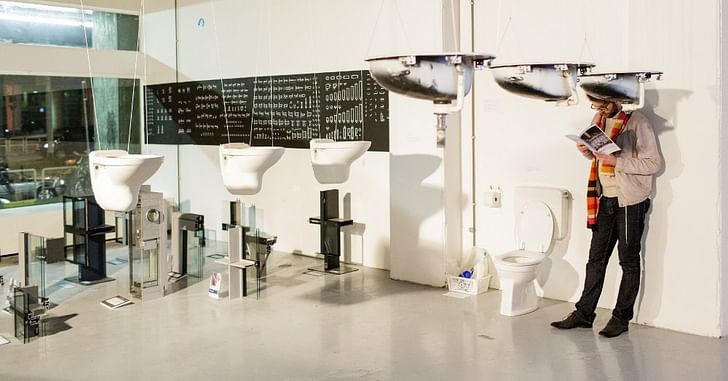

by Jaakko van ‘t Spijker
It was an event with a pop-up nature, announced only days before and with no one really knowing what to expect. On Friday night, November 16th, the first findings of a studio in the Harvard GSD program, dealing with ‘the Elements of Architecture’, were publicly presented in a packed Dependance at the Schieblock in Rotterdam. It unfolded as an unpretentious evening of public brainstorming, with a strong guiding presence of Rem Koolhaas that demonstrated the powerful potential of education by research. Although no finite conclusions were drawn the night was a success. It turned out to be one of those moments of synergy when content, format and location reinforce each other.

Koolhaas likes to approach architecture non-architecturally just as much as he prefers to keep it away from design if he can. Around a decade ago he and his students researched Cities (larger than architecture) in the Harvard project on the city. This led to the studies on shopping, the Pearl River Delta in China and Lagos in Africa. This project zooms in on to elements (smaller than architecture). It’s an outspoken statement to dedicate a studio to the research of isolated building parts. It’s a reaction to parametric design that has enabled limitless design possibilities including the blurring of traditional ‘borders’ between building parts (floor becomes wall becomes ceiling etc.). A lot of progressive architecture theory deals with this, while simultaneously a large counter movement denounces all computer generated architecture as fanciness without content. By paying attention to primary architectural elements this Harvard studio engages with the discussion from a surprising, indirect angle. In addition to this, Koolhaas remarked that the studio may contribute to lowering the threshold of architectural discourse by discussing it through basic notions that everyone intuitively knows and understands.

The debaters were Rem Koolhaas, and Stephan Trüby (the project teachers), Manfredo di Robilant, Sebastian Marot, Antoine Picon (functioning as external critics) and the debate was moderated by Tom Avermate.
This was not yet the case during the (interim) presentation in Rotterdam. At this stage the discussion offered no finite conclusions and plenty of in-crowd terminology. The event was very good, however, because the various elements of the evening generated a compelling synergetic momentum.
The subject contributed strongly to this. Even in its rough form, the focus on elements, limited as they may appear at a first glance, opened up all kinds of directions, discourses and polarities; examples of which were the notion of system versus device and standardization versus design. Remarkably often, ideas from the ‘60’s and ‘70’s popped up in the discussion, varying from appraisal for Christopher Alexander’s Pattern Language to the utopian projects of Superstudio and Archizoom (ceiling!, floor!).
The format of the evening, the combination of exhibition and debate, was successful. The raw exhibition consisted largely of actual building parts, obtained by the students from construction sites, in combination with analysis booklets. These first findings by the students showed the richness that gets unveiled as a result of unleashing obsessive energy and dedication onto seemingly simple notions like a partition wall or a balcony. Welcome to the OMA method, the exchange with the students seems to work. The debaters were Rem Koolhaas, and Stephan Trüby (the project teachers), Manfredo di Robilant, Sebastian Marot, Antoine Picon (functioning as external critics) and the debate was moderated by Tom Avermate. Thanks to the open format of the evening, the debate itself was open, informal and exploratory although the debaters steered clear from outspoken positions.
Also the location added to the success of the night. As the students are all located in Rotterdam, this was where the event was held. The Dépendance in the Rotterdam Schieblock finds itself just around the corner from the OMA office. It is housed in a written-off office building that was revamped into a central, public, low-threshold, urban element and it absorbed the event seamlessly. The building fitted the roughness of the presentations and complied with the project’s idea. The event facilitated a rare public presence of both OMA and Harvard in the city but in doing so enriched the organizers as well as the city itself.

Due to the freshness and ‘work in progress’- nature of the theme and project, plenty of loose ends and unanswered questions remained. How exactly are the architectural elements defined? Will they be looked at in combination with one another? What is the end goal of the project? In fact, many of these were addressed during the discussion itself, by panellists as well as by the public. However, this was not an evening for finite arguments and readymade conclusions. The value of the night was that visitors were given an early participative glance into the next AMO/Harvard enterprise. Even without clear conclusions, the night harboured the kind of energetic frenzy and excitement that comes with eager ‘intelligent speculation’, as Koolhaas called it. The elements of architecture have plenty to say. And in this format, in which a goal of the project (making architectural discourse more accessible) became part of its method (public access to the development stage), the project was enriching for the participant students as well as for those of the Rotterdam public.

Ir. Jaakko Erik van ´t Spijker, MSc. Jaakko van ´t Spijker is an architect and urban planner who lives in and operates from The Netherlands. After graduating from Delft Technical University in 1996, in over 15 years of professional experience, Jaakko van ´t Spijker has been ...
2 Comments
I am interested to hear any further outcome from this. As I continue to focus my architectural education toward Digital Design and Fabrication, because that is what I enjoy doing, the more questions I have to whether it is the 'right' thing to do.
I find OMA creates some of today's most compelling architecture using standard off-the-shelf parts in unique and exhilarating ways. Design from the Sweets Catalog, as one of my prof's puts it. From what I understand Seattle Public Library came in under-budget and on schedule, how many signature projects can make the same claim? Do we need to supplement mass production with mass customization to create tomorrows architecture? I feel OMA has been proving otherwise.
What does "digital design" mean? Is it that you use computer aided software to help you in your aid to "design?" If that is the case, I think it is safe to assume you are not doing it 'wrong." Most architects and fabricators uses some sort of a software to help them design, either via, Rhino, AutoCad, Solidwork and many others.
More importantly I am just curious what makes Digital Design different from an analogue method of designing.
Block this user
Are you sure you want to block this user and hide all related comments throughout the site?
Archinect
This is your first comment on Archinect. Your comment will be visible once approved.